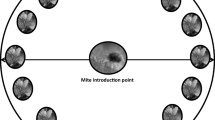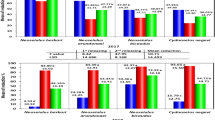Abstract
The effect of an integrated pest management (IPM) package, host plantresistance, Chrysoperla carnea predation and neem oil wereevaluated against the spider mite Tetranychus ludeni oneggplant(Solanum melongena L.) fields in 1996 and 1997, byestimating the mite population density and yield levels. Compared with the IPMpackage (Panruti local, C. carnea plus neem oil), thestandard (susceptible) eggplant variety (MDU1) grown by farmers andtreated with an acaricide (dicofol) had significantly higher mite densities.Thepredator C. carnea was recorded in significantly lowernumbers in plots with the standard variety compared to a resistant variety(panruti local) with the full IPM package. Eggplant yield level and crop valuewere highest in the IPM-treated plots followed by Panruti local plusC. carnea. The standard variety treated with an acaricidehad the lowest yield and value. These results indicated the usefulness of hostplant resistance complemented by biorational control agents, such asC. carnea and neem oil, that these are suitable componentsin an IPM programme for managing the spider mite in endemic areas.
Similar content being viewed by others
References
Ahmed M.T. and Ismail S.M.M. 1996. Effect of reduced application rates of dicofol and pirimiphosmethyl on strawberries and common beans on their residue content and crop production. J. Agr. Food Chem. 44: 3694–3697.
Channabasavanna G.P. 1971. The present status of our knowledge of Indian plant feeding mites. In: Proceedings of the 3rd International Congress Acarology., Prague, pp. 201–204.
Dennehy T.J. and Granett J. 1984. Spider mite resistance to dicofol in San Joaquin Valley cotton: interand intraspecific variability in susceptibility of three species of Tetranychus (Acari: Tetranychidae). J. Econ. Entomol. 77: 1381–1385.
Goodwin S. 1990. Seasonal abundance and control of spider mites Tetranychidae infesting commercial strawberries in Coastal New South Wales, Australia. J. Austral. Entomol. Soc. 29: 161–166.
Goyal M. 1982. The spider mite, Tetranychus telarius L. (Tetranychidae: Acarina) on glass house brinjal, Solanum melongena. Sci. Cult. 48: 220–221.
Herron G.A., Edge V.E., Wilson L.J. and Rophail J. 1998. Organophosphate resistance in spider mites (Acari: Tetranychidae) from cotton in Australia. Exp. Appl. Acarol. 22: 17–30.
Isenhour D.J., Wiseman B.R. and Layton R.C. 1989. Enhanced predation by Orius insidiosus (Hemiptera: Anthocoridae) on larvae of Heliothis zea and Spodoptera frugiperda (Lepidoptera: Noctuidae) caused by prey feeding on resistant corn genotypes. Environ. Entomol. 18: 418–422.
Kartohardjono A. and Heinrichs E.A. 1984. Populations of the brown planthopper, Nilaparvatha lugens (Stål) (Homoptera: Delphacidae), and its predators on rice varieties with different levels of resistance. Environ. Entomol. 13: 359–365.
Kumar V. and Sharma D.D. 1993. Bio-ecology and chemical control of spider mite, Tetranychus ludeni Zacher on Okra. Indian J. Plant Prot. 21: 68–71.
New T.R.R. 1975. The biology of Chrysopidae and Hemerobiidae (Neuroptera) with reference to their usage as biocontrol agents: a review. T. Roy. Ent. Soc. London 127: 115–140.
New T.R.R. 1988. Neuroptera. In: Minks A.K. and Harrewijn P. (eds), Aphids: Their Biology, Natural Enemies and Control. Elsvier, Amsterdam, pp. 249–258.
Pal P.K., Somchoudhury P.K., Sarkar P.K., Mikherjee A.B. and Lohar N. 1989. Approaches to integrated control of Tetranychus cinnabarinus on egg plant. In: Channabasavanna G.P. and Viraktamath C.A. (eds), Progress in Acarology, pp. 453–459.
Palaniswamy S. and Subramaniam T. R. 1977. A note on the ovicidal action of certain commonly used acaricides. Sci. Cult. 43: 351–352.
Patil B.V. 1989. Use of pyrethroids on cotton and build up of population of the carminespider mite, Tetranychus cinnabarinus (Acari: Tetranychidae). In: Channabasavanna G.P. and Viraktamath C.A. (eds), Progress in Acarology, pp. 427–431.
Pree D.J. 1987. Inheritance and management of cyhexatin and dicofol resistance in the European red mite (Acari: Tetranychidae). J. Econ. Entomol. 80: 1106–1112.
Reddy G.V.P. and Guerrero A. 2000. Pheromone-based integrated pest management to control the diamondback moth, Plutella xylostella in cabbage fields. Pest Man. Sci. 56: 882–888.
Reddy G.V.P. and Manjunatha M. 2000. Laboratory and field studies on the integrated pest management of Helicoverpa armigera on cotton, based on pheromone trap catch threshold level. J. Appl. Entomol. 124: 213–221.
Reddy G.V.P. and Baskaran P. 1991. Biology and varietal preference of Tetranychus ludeni Zacher (Acari: Tetranychidae) on four varieties of eggplant, Solanum melongena L. Mysore J. Agri. Sci. 25: 331–334.
Reddy G.V.P. and Baskaran P. 2001. Damage potential of spider mite Tetranychus ludeni Zacher (Acari: Tetranychidae) on four varieties of eggplant. Exp. Appl. Acarol., in revision.
Sharanabasava H. and Manjunatha M. l998a. Predator prey interaction between Chrysoperla carnea Stephens (Chrysopidae: Neuroptera) and Tetranychus neocaledonicus Andre (Tetranychidae: Acari) on okra. Abstract of paper presented at 10th International Congress of Acarology, 5–10 July 1998. Australian National University, Canberra, Australia, 203p.
Sharanabasava H. and Manjunatha M. 1998b. Reproductive biology and feeding potential of Chrysoperla carnea Stephens (Neuroptera: Chrysopidae) on Tetranychus neocaledonicus Andre (Acari: Tetranychidae). Ann. Plant Prot. 6: 115–118.
Sharanabasava H., Manjunatha M., Hanchinal S.G. and Kulkarni S.V. 1999. Interaction of Chrysoperla carnea with botanicals and recommended pesticides used against spider mite Tetranychus neocaledonicus. J. Acarol. 14: 16–21.
Singh R.N. 1995. Studies on seasonal abundance of Tetranychus ludeni Zacher (Acari: Tetranychidae) on cowpea (Vigna unguiculata Savi.). J. Rec. Adv. Appl. Sci. 10: 1–2.
Singh S.P., Rao N.S. and Kumar K.K. 1981. Occurrence of vegetable mite, Tetranychus neocaledonicus Anrde. on passion fruit, Passiflora edulis Sims. and evaluation of certain acaricides against it. Pestology 5: 25–27.
Srinivasa N. and Sugeetha G. 1999. Bioeffectiveness of certain botanical synthetic pesticides against okra spider mite, Tetranychus macfarlanei. J. Acarol. 15: 1–4.
Trumble J.T. and Hare J.D. 1997. Tritrophic interactions in the management of Spodoptera exigua and other pests on celery. New Developments in Entomology 1: 117–134.
Wilcox F. and Howland A.F. 1961. Control of aphids and spider mites on strawberries with dusts and low and high gallonage sprays. J. Econ. Entomol. 54: 287–292.
Author information
Authors and Affiliations
Rights and permissions
About this article
Cite this article
Reddy, G. Comparative effectiveness of an integrated pest management system and other control tactics for managing the spider mite Tetranychus ludeni (Acari: Tetranychidae) on eggplant. Exp Appl Acarol 25, 985–992 (2001). https://doi.org/10.1023/A:1020661215827
Issue Date:
DOI: https://doi.org/10.1023/A:1020661215827




